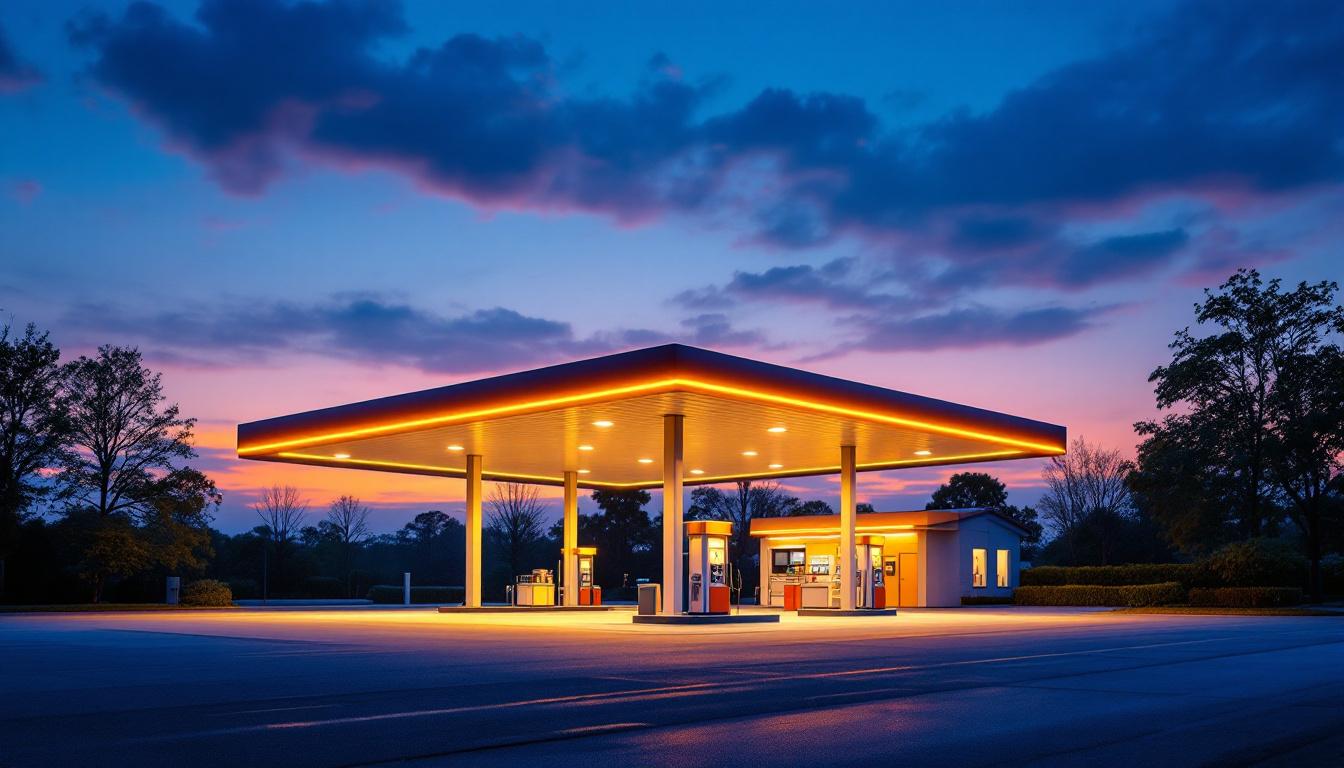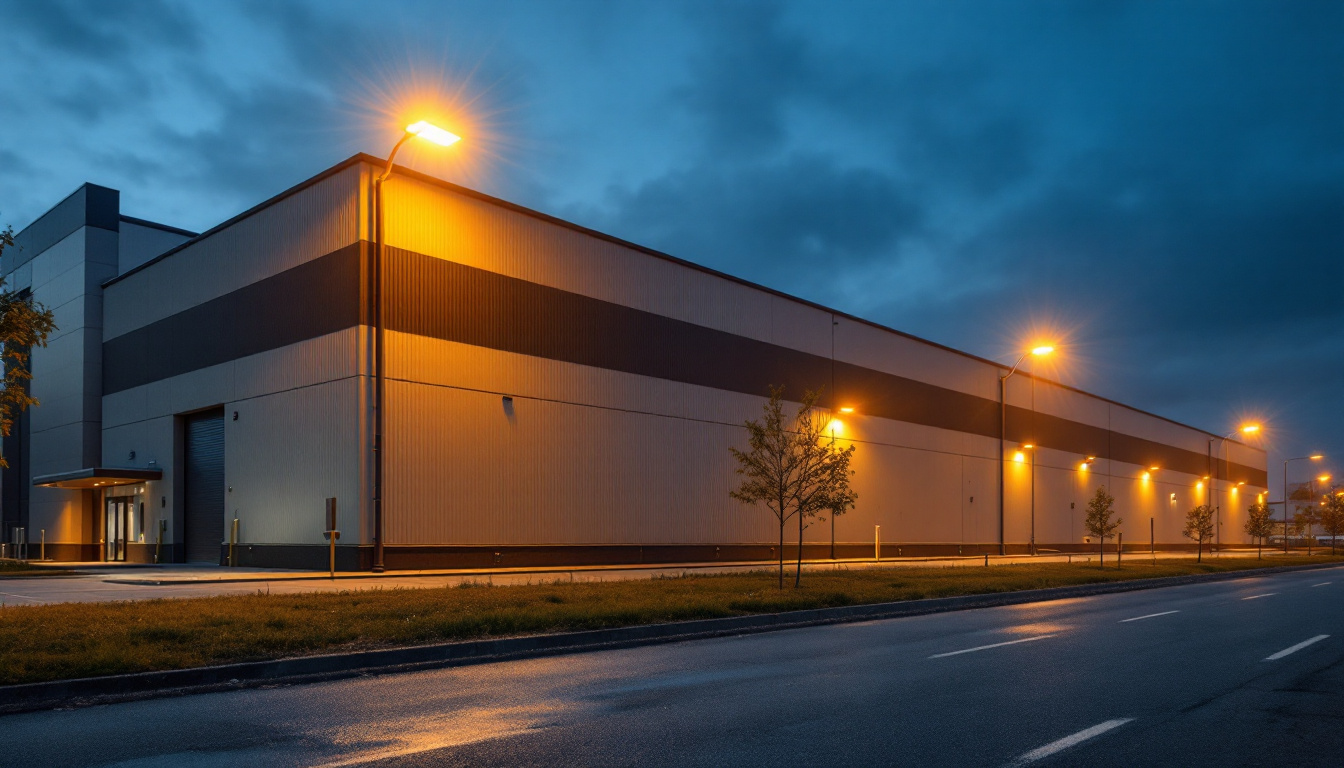
Gas station lighting plays a crucial role in ensuring safety, visibility, and operational efficiency in one of the most frequented public spaces. For lighting contractors, understanding the nuances of gas station lighting solutions is essential to delivering systems that meet regulatory requirements, enhance customer experience, and optimize energy consumption.
Modern gas station lighting goes beyond mere illumination; it integrates advanced technologies and design principles to address unique challenges such as glare control, uniformity, and durability in outdoor environments. This article explores the evolving role of gas station lights within contemporary lighting solutions, focusing on technology trends, design considerations, and practical applications.
One of the most significant advancements in gas station lighting is the shift towards LED technology. LED lights not only provide superior brightness and energy efficiency but also have a longer lifespan compared to traditional lighting options. This longevity translates to reduced maintenance costs and less frequent replacements, which is particularly beneficial for gas stations that operate 24/7. Moreover, the ability to adjust the color temperature of LED lights allows gas stations to create a welcoming atmosphere, enhancing the overall customer experience while ensuring that the area remains safe and well-lit during nighttime operations.
Additionally, the integration of smart lighting systems is becoming increasingly popular in gas station design. These systems can be programmed to adjust brightness based on the time of day or the presence of customers, further optimizing energy usage. For instance, during peak hours, lights can be set to maximum brightness to ensure safety and visibility, while dimming during quieter periods can lead to significant energy savings. Furthermore, smart lighting can be linked to security systems, providing real-time alerts and enhancing the safety of both customers and staff. As gas stations continue to evolve, the implementation of such innovative lighting solutions will be pivotal in meeting the demands of modern consumers and regulatory standards.
One of the primary functions of gas station lighting is to ensure the safety of motorists, pedestrians, and employees. Proper illumination reduces the risk of accidents by enhancing visibility around fuel pumps, payment kiosks, and entry/exit points. Well-lit environments also deter criminal activities such as theft and vandalism, which are concerns for both customers and operators.
Studies have shown that improved lighting can reduce crime rates significantly in outdoor commercial areas. For lighting contractors, this means selecting fixtures that provide consistent, glare-free light with adequate brightness levels to cover key zones. Additionally, the strategic placement of lighting fixtures can create a sense of openness and visibility, which is crucial during late-night hours. This not only reassures customers but also allows staff to monitor activities more effectively, further enhancing the overall security of the premises.
Gas stations operate around the clock, often in varying weather conditions. Effective lighting ensures that customers can easily navigate the site, read signage, and perform transactions without difficulty. This contributes to a positive customer experience and can influence repeat business.
Moreover, energy-efficient lighting solutions can substantially reduce operational costs for gas station owners. For contractors, recommending LED fixtures and smart controls can deliver long-term savings while maintaining high performance. Beyond cost savings, the use of advanced lighting technology can also enhance the aesthetic appeal of the gas station. By employing dynamic lighting designs that adjust to the time of day or weather conditions, gas stations can create an inviting atmosphere that encourages customers to stop and refuel, not just their vehicles, but also their desire for convenience and comfort. Furthermore, integrating motion sensors can optimize energy usage by ensuring that lights are only active when needed, further promoting sustainability and efficiency in operations.
Historically, gas stations relied on high-intensity discharge (HID) lamps such as metal halide or high-pressure sodium lights. While these provided adequate illumination, they had drawbacks including high energy consumption, longer warm-up times, and shorter lifespans.
The shift to LED lighting has transformed gas station illumination by offering superior energy efficiency, instant-on capabilities, and longer service life. LEDs also provide better color rendering, which improves visibility and the overall ambiance of the station. This transition not only enhances the safety of the environment for customers and employees but also significantly reduces operational costs. With the ability to last up to 25 times longer than traditional bulbs, gas stations can experience fewer replacements and lower maintenance costs, allowing for a more streamlined operation.
Modern gas station lighting systems increasingly incorporate smart controls that allow for dynamic adjustment of light levels based on real-time conditions. Motion sensors, ambient light sensors, and programmable timers enable lighting to adapt to traffic flow and daylight availability, further optimizing energy use.
Integration with building management systems (BMS) allows operators to monitor and control lighting remotely, facilitating preventive maintenance and reducing downtime. Lighting contractors must be proficient in installing and configuring these advanced systems to meet client expectations. Furthermore, the data collected from these smart systems can provide valuable insights into customer behavior and peak usage times, enabling gas station owners to make informed decisions about staffing and inventory management. This level of integration not only enhances operational efficiency but also contributes to a more sustainable business model.
Gas station lights must withstand harsh environmental conditions, including exposure to fuel vapors, temperature fluctuations, moisture, and dust. Modern fixtures are designed with robust materials and sealed enclosures rated for outdoor use, ensuring longevity and consistent performance.
Contractors should prioritize fixtures with appropriate ingress protection (IP) ratings and certifications to guarantee reliability in demanding settings. Additionally, advancements in materials science have led to the development of corrosion-resistant coatings and UV-stabilized plastics, further extending the lifespan of lighting fixtures in outdoor environments. With the increasing frequency of extreme weather events, such as heavy rains and snowstorms, the resilience of lighting systems has become a critical factor in maintaining operational continuity. Investing in high-quality, durable lighting solutions not only enhances safety but also reinforces the gas station’s commitment to providing a reliable service to its customers.
Uniform illumination across the fueling area is vital to avoid dark spots that can compromise safety. Lighting contractors must carefully plan fixture placement and beam angles to achieve even light distribution.
Glare control is equally important to prevent discomfort for drivers and pedestrians. Using shielded fixtures, diffusers, and appropriate mounting heights can reduce direct glare and improve visual comfort.
Choosing the right color temperature impacts both visibility and the psychological perception of the space. Neutral to cool white light (typically between 4000K and 5000K) is preferred in gas stations as it enhances contrast and visibility without causing harshness.
A high CRI (above 70) ensures that colors appear natural and signage is easily readable, which is critical for safety and branding purposes.
Gas station lighting must comply with local and national standards related to brightness, energy efficiency, and environmental impact. For example, regulations may specify maximum allowable light pollution or mandate the use of energy-efficient technologies.
Lighting contractors must stay informed about these requirements and ensure that their installations meet or exceed them to avoid penalties and support sustainable practices.
Energy costs represent a significant portion of a gas station’s operational expenses. Implementing energy-efficient lighting solutions such as LEDs combined with smart controls can reduce consumption by up to 60% compared to traditional lighting.
Contractors can also recommend solar-powered lighting or hybrid systems where feasible, contributing to further reductions in grid dependence and carbon footprint.
Minimizing light pollution is an important consideration, especially for stations located near residential areas or natural habitats. Using full cutoff fixtures and directing light only where needed helps reduce skyglow and glare.
Environmentally responsible lighting design not only complies with regulations but also enhances community relations and supports corporate social responsibility goals.
Every gas station has unique layout and lighting needs. Conducting a thorough site assessment including traffic patterns, surrounding environment, and existing infrastructure is critical to designing an effective lighting system.
Customized solutions that consider these factors will deliver optimal performance and client satisfaction.
Proper installation is key to maximizing the lifespan and effectiveness of gas station lighting. Contractors should follow manufacturer guidelines, ensure secure mounting, and verify electrical connections to prevent failures.
Attention to grounding and surge protection is also essential given the outdoor exposure and potential for electrical disturbances.
Regular maintenance including cleaning fixtures, checking for damage, and replacing components as needed helps sustain lighting quality and safety. Lighting contractors can offer maintenance contracts to ensure ongoing performance.
Upgrading older systems to LED and integrating smart controls can be positioned as value-added services that enhance energy savings and operational control.
Gas station lighting is a specialized segment within modern lighting solutions that demands a comprehensive understanding of safety, technology, design, and sustainability. For lighting contractors, mastering these aspects enables the delivery of systems that not only meet regulatory standards but also improve customer experience and operational efficiency.
Advancements in LED technology, smart controls, and durable fixture design have revolutionized gas station lighting, making it more energy-efficient and adaptable than ever before. By focusing on uniformity, glare control, and compliance, contractors can create lighting environments that enhance safety and security.
Ultimately, the role of gas station lighting in modern lighting solutions is pivotal—not just as a functional necessity but as a strategic component that supports business objectives and environmental stewardship.
Ready to elevate your gas station lighting projects with the latest LED technology and smart controls? Look no further than LumenWholesale, where we provide lighting contractors with high-quality, spec-grade lighting products at unbeatable wholesale prices. Our extensive selection is designed to meet the highest industry standards, ensuring your installations are reliable, efficient, and compliant. Plus, with free shipping on bulk orders, you can enjoy premium lighting solutions at the best value — all without hidden fees or compromises. Enhance safety, security, and customer satisfaction in your next project. Experience the difference in quality, affordability, and convenience at LumenWholesale — your partner in Wholesale Lighting at the Best Value.

Discover how outdoor wall lights with built-in outlets are revolutionizing the work of lighting contractors.

Discover essential insights on recessed lighting angled ceilings for contractors, including design tips, installation best practices, and key benefits to enhance your projects—boost efficiency and client satisfaction today!.

Discover how industrial exterior lighting can enhance profitability through strategic installations.

Illuminate your projects with sustainable solutions! Discover essential insights and expert tips on selecting and installing solar-powered front porch lights, tailored specifically for lighting contractors.